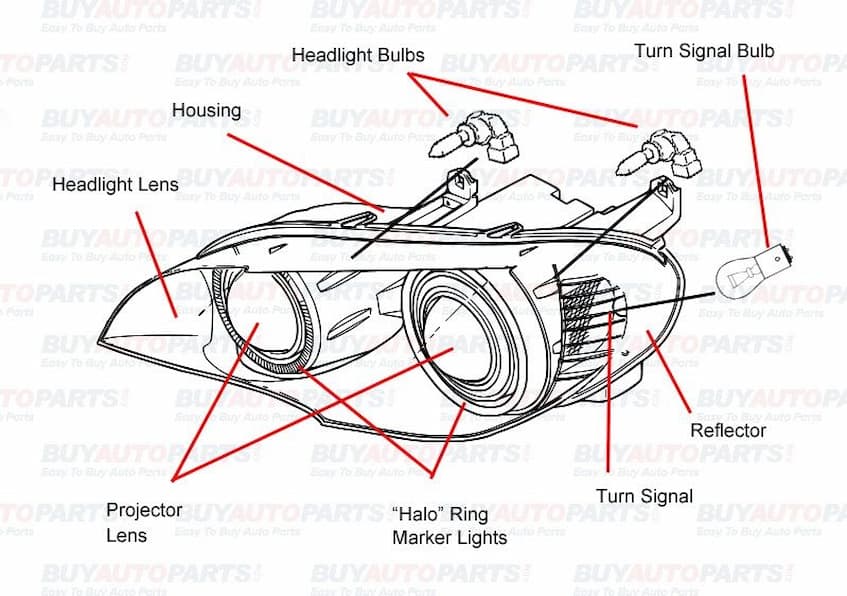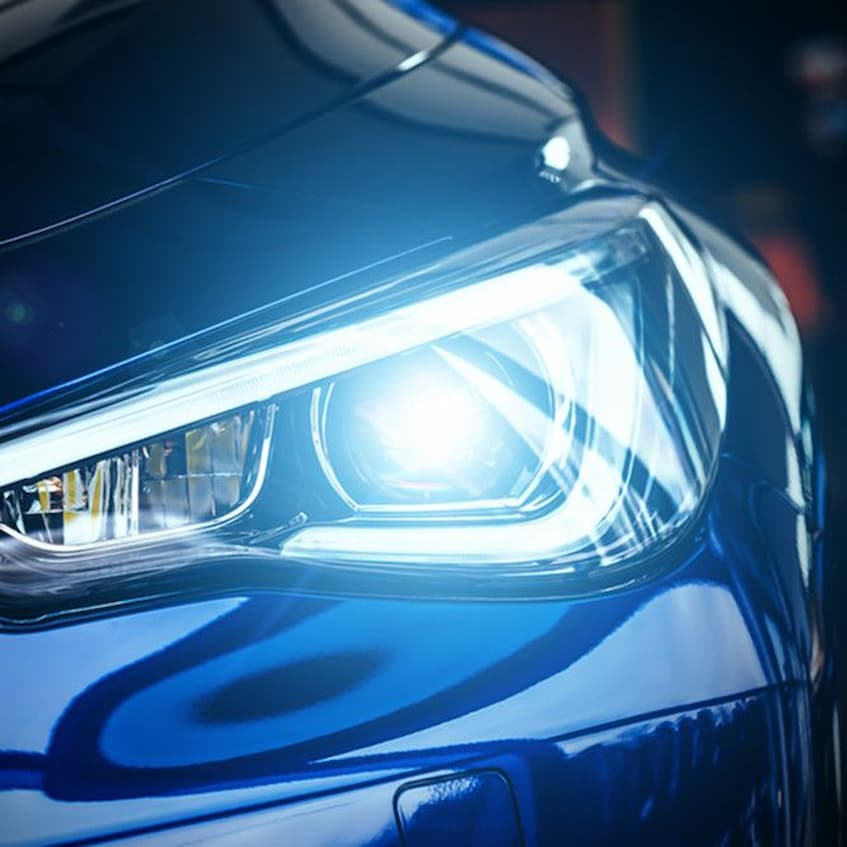
Headlight Parts: Common Uses, Problems and Replacements
Basic safety systems have remained largely unchanged since the inception of cars. Headlights and brakes help you see and stop when needed, and these are essential car components that no active or passive safety feature can replicate.
Headlights in particular illuminate the road ahead in low-light conditions, bad weather, and at night, ensuring you spot obstacles, other vehicles, and pedestrians on time and make necessary adjustments to speed or direction. That they’re car parts mandated by state and federal laws speaks more to the role they play in overall safety.
Contents
Anatomy of Car Headlights

Located at the front of the vehicle, the left and right headlight assemblies consist of several key headlight parts. Housings are the outer (metal or thermoplastic) shells holding all headlight components together and ensuring they’re protected from external factors such as heat, dust and moisture. At the front of the assembly is a translucent lens cover, often made of impact-resistant polycarbonate.
This amplifies and focuses high and low beams generated from bulbs or diodes. To disperse light at correct distances and angles, assemblies make use of coated plastic or metal reflectors. And running the whole assembly is a network of wires, connectors, fuses and relays, with power supplied from the car alternator while driving, and the battery while parked and with the engine off.
Headlight Types by Bulb or Diode Configuration
Headlights have evolved along with other car technologies, ensuring improved visibility, higher clarity and brightness, longer run times, and lower power draw. Common light sources and headlight types include:
- Halogen bulbs: These are a dying breed, seen in older vehicles and in budget cars in entry-level trim. Headlights with halogen bulbs are recognisable by their yellow/orange tint. They produce light by heating a tungsten filament set inside a vacuum. While affordable and relatively bright, halogen bulbs are affected by increased heat, which shortens their lifespan to an average of 500 hours, meaning more frequent replacements. They’re also power-hungry and can impact battery drainage.
- High-Intensity Discharge (HID) headlights: Also known as Xenon lights, by the xenon gas filling the glass enclosure housing the electrodes. HIDs or Xenon headlight produce light when current passes through the electrodes. They’re recognisable by intense bluish/purple colours and offer high visibility and brightness, longer lifespans and relatively low power draw. Complex designs and high prices have meant they’ve been replaced with LEDs.
- LEDs: Light-emitting diodes of LEDs are a type of headlight design known for the natural colour reproduction, high brightness, and exceptionally low power needs. They produce light when an electrical current passes through a semiconductor or a diode. LEDs are praised for their compact size, high efficiency, and the flexibility for some interesting headlight shapes and designs. And the durability (especially heat resistance) is rated at over 50,000 working hours with lights, the latest LED chips.
- Laser headlights: Similar in construction and working principle to LEDs, laser headlights utilise several blue laser diodes that shine onto a phosphorous lens. This excites the phosphorus, producing a bright white light. Laser lights are exceptionally bright (several times that of high-end LEDs), project light further and wider, and require minute power levels. They also include interesting technologies, such as auto beam control to prevent glare in oncoming traffic.
Common Issues in Car Headlights

While construction, build, and materials differ in different headlight designs, all are prone to wear. Some will also malfunction sooner or later. Common signs and causes to look for are:
- Blown and burnt-out bulbs and failing diodes: Dim, fading and blown-out bulbs, specifically halogens, are the main reason headlights fail. Eventually, they’ll need to be replaced. The same applies to diodes. These degrade as they near their rated lifespan, affecting brightness. The main cause for failure in both is high heat.
- Lens oxidation: Dimming can also be from oxidised and cloudy, yellowed lens, caused by longer exposure to UV radiation. An inexpensive restoration process removes oxidised layers and allows all generated light to pass through.
- External contaminants: Accumulated dust, road debris and insects can all hamper headlight performance. Clean lens covers regularly. A more serious issue is moisture that penetrates seals, leading to condensation and light scatter.
- Wiring issues: Buzzing noises, uneven beams, frayed insulation, blown fuses, faulty relays, and lights not turning on point to a range of issues in the wiring and connectors.
Choosing Replacements
Auto headlights that are dim even after replacing faulty or damaged headlight parts and conducting proper cleaning and lens restoration require a compatible replacement. This can be an original equipment assembly and the same unit that goes into the factory vehicle during assembly, or an OE-spec replacement from third-party brands, ensuring proper fit and the same performance.
The prices of aftermarket equipment will always be cheaper, but not inferior to the factory headlight. Often, aftermarket headlights from specialist brands can provide better brightness levels, more natural colour temperatures and superior builds and materials for extended durability.
Needless to say, also replace headlights with accumulated moisture, cracked lenses and misaligned reflectors. Physically sound units might only need replacement wiring harnesses and adapters. When buying, consider housing and lens materials, decent external seals, lights with UV coatings and proper IP ratings. Also check for rated brightness in Lumens, colour temperatures in Kelvin (for reduced fatigue and glare) and beam patterns for proper light dispersion.


Sorry, the comment form is closed at this time.